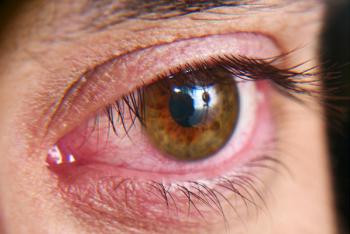
Is Ranibizumab Monotherapy Superior to Combination Therapy in Treating Polypoidal Choroidal Vasculopathy?
Ranibizumab, in combination with prompt verteporfin photodynamic therapy, is more effective in treating polypoidal choroidal vasculopathy compared with ranibizumab monotherapy, according to a study published in JAMA Ophthalmology.
Ranibizumab, in combination with prompt verteporfin photodynamic therapy (vPDT), is more effective in treating polypoidal choroidal vasculopathy (PCV) compared with ranibizumab monotherapy, according to a
In general, PCV is more prevalent in East Asian populations, with prevalence ranging from 22.3% to 61.6%. However, increased use of multimodality imaging and indocyanine green angiography (ICGA) has led to more diagnoses across all patient groups, including Western populations.
The condition is recognized as a subtype of neovascular age-related
Although PVC does respond well to anti–vascular endothelial growth factor (anti-VEGF) monotherapy, polypoidal lesions and associated branching vascular network complex can persist after treatment, resulting in the risk of recurrent bleeding and poor outcomes. For this reason, polypoidal lesion regression may be used as an important endpoint in PCV management.
Researchers used data from the EVEREST II randomized clinical trial to evaluate differences in treatment outcomes at 24 months among those who received combination therapy with intravitreal ranibizumab and vPDT vs those who received ranibizumab monotherapy.
The phase IV, double-masked trial was conducted among Asian participants between August 2013 and March 2017. Investigators used ICGA to determine symptomatic macular PCV.
All participants were randomized 1 to 1 to receive 0.5 mg of ranibizumab plus vPDT (combination therapy; n = 146) or ranibizumab 0.5 mg plus sham PDT (monotherapy; n = 128). Three consecutive monthly ranibizumab injections were carried out, in addition to a pro re nata regimen. Average participant age was around 68 years, and the majority (69.9%) were male.
At baseline, average (SD) best-corrected visual acuity (BCVA) letter score was 61.1 (approximate Snellen equivalent 20/63) (13.2), and the average central subfield thickness was 413.3 (157.2) μm.
Analyses found that at 24 months:
- Adjusted average BCVA gains were 9.6 letters in the combination therapy group and 5.5 letters in the monotherapy group (average difference, 4.1 letters; 95% CI, 1.0-7.2 letters; P = .005).
- Combination therapy was superior to monotherapy in terms of complete polypoidal lesion regression ( 56.6% vs 26.7% of participants; P < .001).
- Participants in the combination group received fewer ranibizumab injections (median, 6.0 [interquartile range (IQR), 4.0-11.0]) than the monotherapy group (median, 12.0 [IQR, 7.0-17.0]) up to month 24.
- The combination group required a median of 2.0 (IQR, 1.0-3.0) vPDT treatments for 24 months, with 75 of 168 participants (44.6%) requiring only 1 vPDT treatment.
Results were consistent with those measured at month 12, researchers found, demonstrating a sustained treatment effect and reduced treatment burden for combination therapy.
In addition, “in EVEREST II, the rates of complete polypoidal lesion regression at months 3, 6, 12, and 24 were consistently higher for combination therapy than for monotherapy at months 3 (71.4% vs 23.3%), 6 (71.3% vs 28.0%), 12 (69.7% vs 33.8%), and 24 (56.6% vs 33.3%).”
Reference
Lim TH, Lai TYY, Takahashi K, et al. Comparison of ranibizumab with or without verteporfin photodynamic therapy for polypoidal choroidal vasculopathy. JAMA Opthalmol. Published online July 16, 2020. doi:10.1001/jamaophthalmol.2020.2443
Newsletter
Stay ahead of policy, cost, and value—subscribe to AJMC for expert insights at the intersection of clinical care and health economics.







































